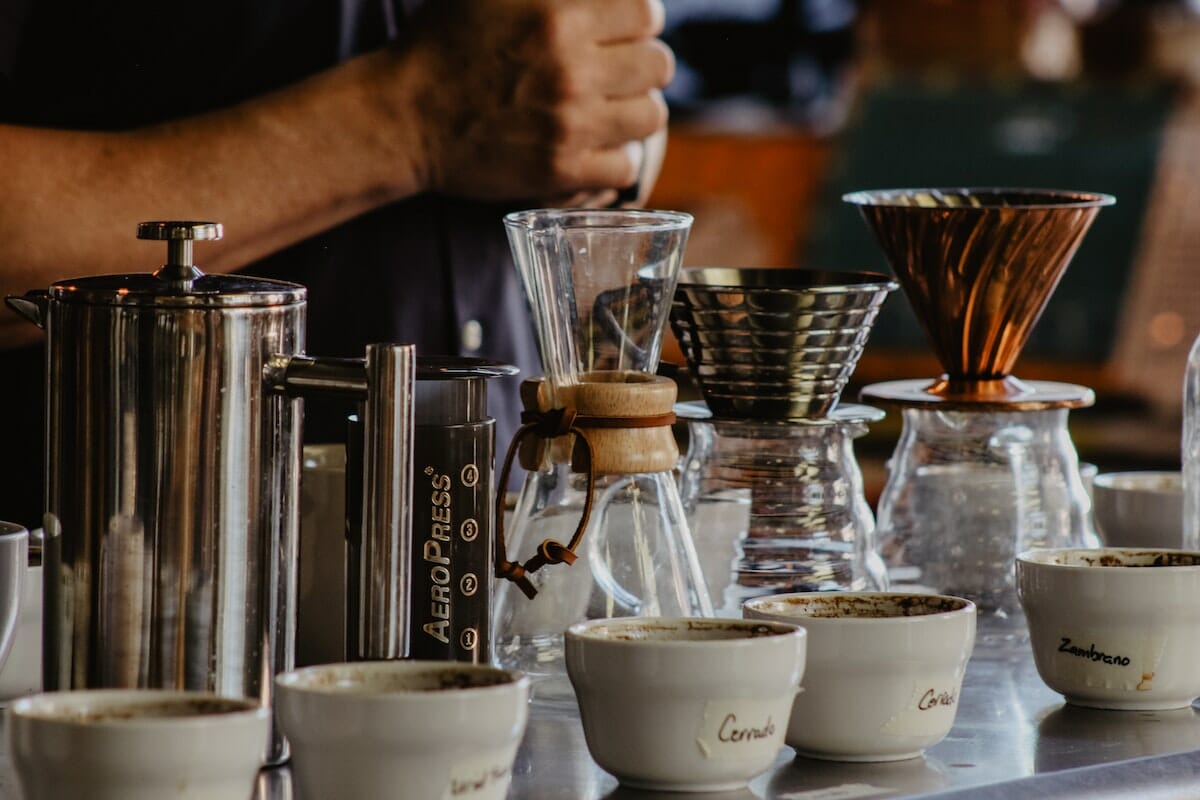In The Science of Brewing Coffee, we covered the different brewing variables (time, temperature, grind, turbulence, filter) that contribute to coffee extraction and how each impacts the taste of coffee. The type of equipment or device used to brew coffee will also have a significant impact on the way the coffee will taste. This is due to the shape and size of the brewer, the batch size, and the technique by which the coffee is brewed. Let’s explore the coffee brewing methods.
Knowing what you want to get out of a particular coffee and understanding what each method has to offer will help you brew better coffee at home. Below are some of our favorite manual brewing methods and how they influence flavor perception. How do you brew?
French Press
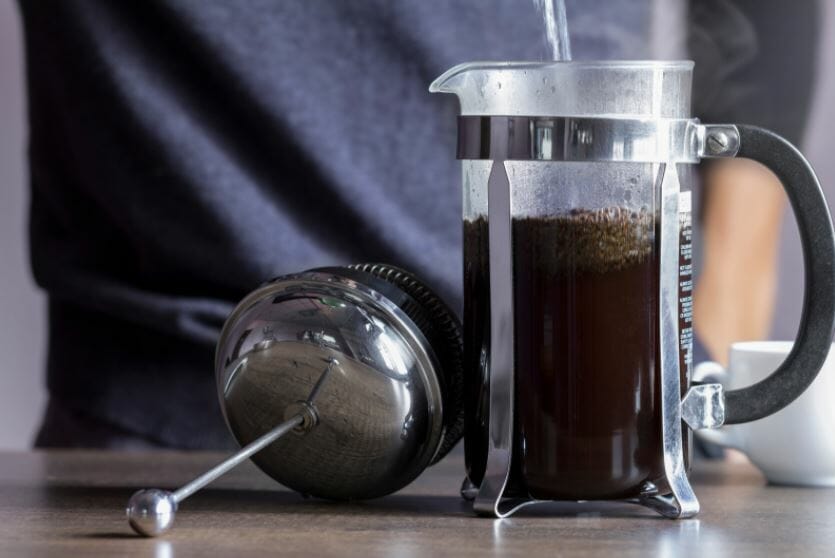
Cup: Emphasis on body/mouthfeel; full-bodied, rich, textured, creamy.
Recommended coffee: Medium to dark roast blends with chocolate and bold roasty coffee flavors.
Staff Pick: Banner Dark | Sightglass Coffee
Filter type: Mesh
Grind size: Coarse
Brew type: Full immersion
Ease of use: Beginner
Great for brewing: 2-3 cups
Pros:
- Easy to use & clean
- Makes multiple cups
- Rich & full-bodied profile
- Doesn’t require any fancy kettles or techniques
Cons:
- Takes over 5 minutes to brew
- Isn’t ideal if you enjoy a clean and sediment-free cup of coffee
- Full immersion brewing is not as efficient at extracting flavors
The French press makes a great cup of coffee and we’d recommend it to anyone looking to make the transition from automatic drip brewer to manual brewing method. Why? Because it’s the easiest method to brew delicious coffee and the most difficult method to mess up. One other thing to consider is how much coffee you plan to brew at one time. The french press is great because it can brew either a single cup or multiple cups (as opposed to your single cup methods such as the Aeropress or Hario v60 pour over).
How to brew coffee with a french press
AeroPress
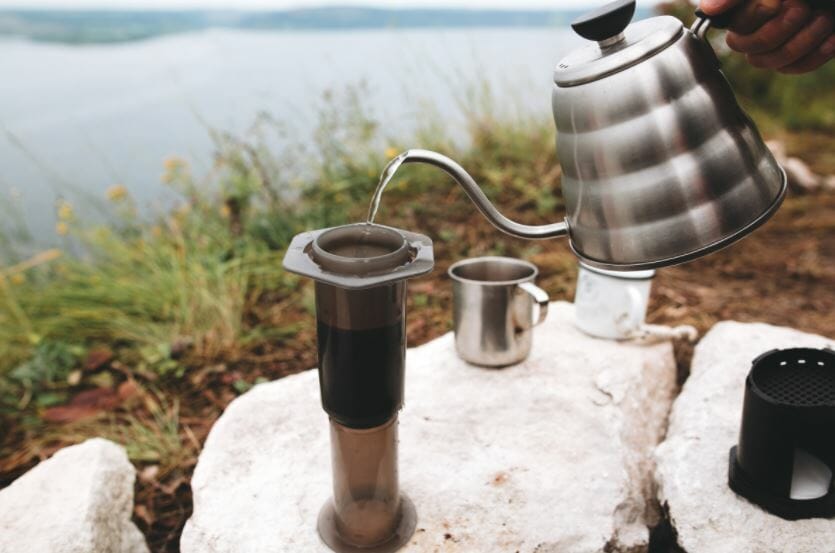
Cup: Versatile: clean and bright or rich and bold coffee
Recommended coffee: Medium roast single-origins and blends.
Staff Pick: Southern Weather | Onyx Coffee Lab
Filter type: Paper
Grind type: Fine to Medium
Brew type: Combines full immersion and percolation brewing
Ease of use: Intermediate
Great for brewing: 1 cup
Pros:
- Versatile
- Easy to pack for travel & is virtually indestructible
- Efficient
- Combines the perks of full immersion and percolation brewing
Cons:
- Isn’t ideal if you are looking for more than 6-10 oz of coffee at a time
- Filter expenses
We recommend the AeroPress if you are looking for versatility. Not only is it one of our go-tos for brewing at home, but it’s the best option for camping or taking on the road to brew a single cup. Nearly indestructible, light, and easy to pack, the AeroPress seems to do it all. It combines the full immersion brewing (grounds are fully immersed in water like a french press) with percolation or pour over brewing (water moves directly through the coffee grounds) and also introduces the variable of pressure which makes it extremely unique. With the AeroPress you can manipulate flavor and the character of a coffee based on how you use it.
How to brew coffee with an AeroPress
Clever Dripper

Cup: Clean and full-bodied with lots of flavor clarity, balanced
Recommended coffee: Medium and dark roast single origins and blends
Staff Pick: Equator Blend | Equator Coffees
Filter type: Paper
Grind type: Medium-coarse
Brew type: Combines full immersion and percolation brewing
Ease of use: Beginner
Great for brewing: 1-3 cups
Pros:
- Easy to use and clean
- Versatile
- Combines the perks of full immersion and percolation brewing
- Doesn’t require any fancy kettles or techniques
Cons:
- Filters expenses
- Full immersion brewing is not as efficient at extracting flavor
The Clever Dripper combines full immersion with pour over brewing and has the ability to function solely as a pour over as well. This low maintenance brewing method combines the full body and mouthfeel you get from a french press with the flavor clarity you get with filter pour over brewing. This is our recommended brewing method for medium-dark roast coffees.
How to brew coffee with a Clever Dripper
Filter Pour Over Methods (Chemex, Hario v60, Kalita Wave)
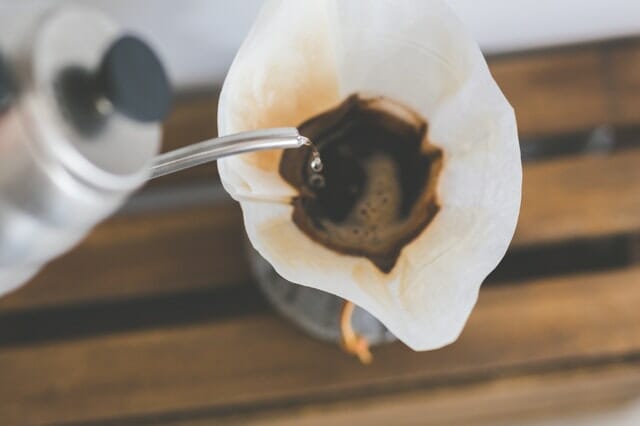
Cup: Emphasis on acidity and flavors; clean, bright, crisp, lively, less body, smooth texture, and more nuance
Recommended coffee: Light to medium roast single origins with citrus and fruity flavors
Staff Pick: Colombia Los Gigantes | Ritual Coffee
Filter type: Paper (see Shop Chemex filters)
Grind type: Medium-fine to Medium-coarse
Brew type: Percolation (drip)
Ease of use: Intermediate to Advanced
Great for brewing: 1-3 cups
Pros:
- Elegant design
- Great flavor clarity
Cons:
- Difficult to perfect extraction
- Filter expenses
- Less durable as glass can break
Filter pour over coffee produces an enjoyable brew that showcases natural features of a coffee best. Whether you’re using the Hario v60, a Chemex or a Kalita Wave, you’ll pour hot water over a bed of coffee grounds and allow the brew to drip through the grounds letting gravity do its thing. The pour over is ideal to use anytime you want to really taste a coffee for what it is, without trying to increase or decrease body, mouthfeel, or acidity. A filter pour over is great for anyone looking for a clean, crisp, lively, or complex cup of coffee.
How to brew coffee with a Hario
How to brew coffee with a Chemex
Moka pot
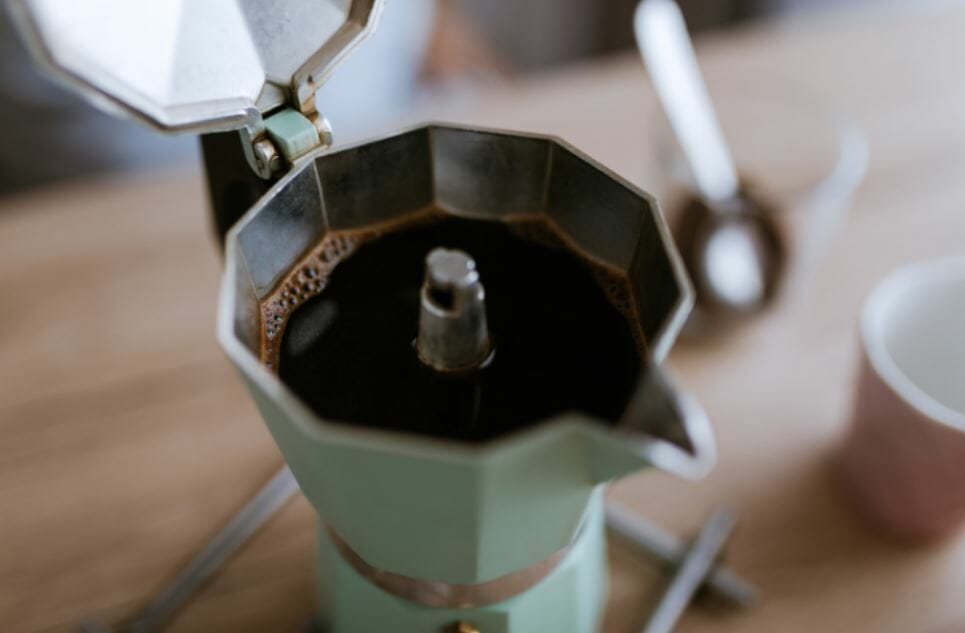
Cup: Emphasis on body/mouthfeel; concentrated (strength), rich, full bodied, resembles espresso in texture and strength
Recommended coffee: Medium to dark roast blends with chocolate and roasty flavors
Staff Pick: Espresso Blend | Sisters Coffee
Filter type: Metal
Grind type: Fine
Brew type: Pressured percolation, percolator
Ease of use: Intermediate to advanced
Great for brewing: 1 cup
Pros:
- Resembles espresso in texture and taste
- Rich and strong (concentrated)
- Indestructible
Cons:
- Difficult to perfect extraction
- Can taste metallic or bitter when poorly extracted
- Isn’t ideal if you are looking to make multiple cups of coffee
The moka pot percolator is a fun way to make coffee resembling espresso. It can make a rich, strong, and intense brew. In this method, boiling water which is pressurized by steam passes through a bed of coffee grounds from bottom to top. It’s difficult to produce a balanced and evenly-extracted brew, but when done right, it can make for a delicious bittersweet treat.
**Curious to learn more about great at-home espresso machines? Check out the Rocket Appartmento Espresso Machine by Clive Coffee.
Drip coffee maker

Cup: Similar to pour over methods, balanced taste profile, rounded body and acidity
Recommended coffee: Medium to dark roast blends with chocolate and roasty flavors
Staff Pick: Driftless Organic Blend | Wonderstate Coffee
Filter type: Paper
Grind type: Medium
Brew type: Percolation (drip)
Ease of use: Beginner
Great for brewing: 3-12 cups
Pros:
- Comforting, convenient & easy to use
- Makes a balanced cup of coffee
- Makes multiple cups of coffee at one time
- Doesn’t require any fancy technique or extra equipment
Cons:
- Many drip machine’s don’t reach ideal temperatures for brewing and extracting coffee flavors
- Not ideal for brewing a single cup of coffee
- Filter expenses
Drip machines can and do make great coffee. They are also the most convenient and easy way to make multiple cups with just the push of a button. One thing to keep in mind is that many of the cheaper machines on the market do not reach high enough temperatures to effectively extract all of the delicious flavor compounds within coffee. This can be an issue especially with lighter roasts that require higher temperatures for brewing which is why you might have coffee taste a bit sour from your drip machine. If you’re looking to upgrade your coffee machine, the SCA has a great list of certified brewers we’ve come to love.
How to brew coffee with a drip coffee maker
Summary
Choosing a particular brewing method ultimately comes down to your preferences. If you have a medium roast or dark roast coffee that is lower in acidity and you are looking for a full bodied and rich brew, the french press will be a great option. If you have a lighter roast with a complex and vibrant quality and want to preserve its acidity, you could gravitate toward a pour over method such as the Chemex or Hario v60. These methods tend to showcase a coffee’s nuanced flavors and makes for a clean, crisp cup of coffee. Looking for a little of that and some body and richness? The AeroPress is our choice when looking for the best of both worlds, and the combination of full immersion brewing with pour over brewing makes it extremely versatile. Hopefully that helps make the case for each brewing method and simplifies your choices in how to get your ideal cup.
Cheat Guide to Perfect Brewing
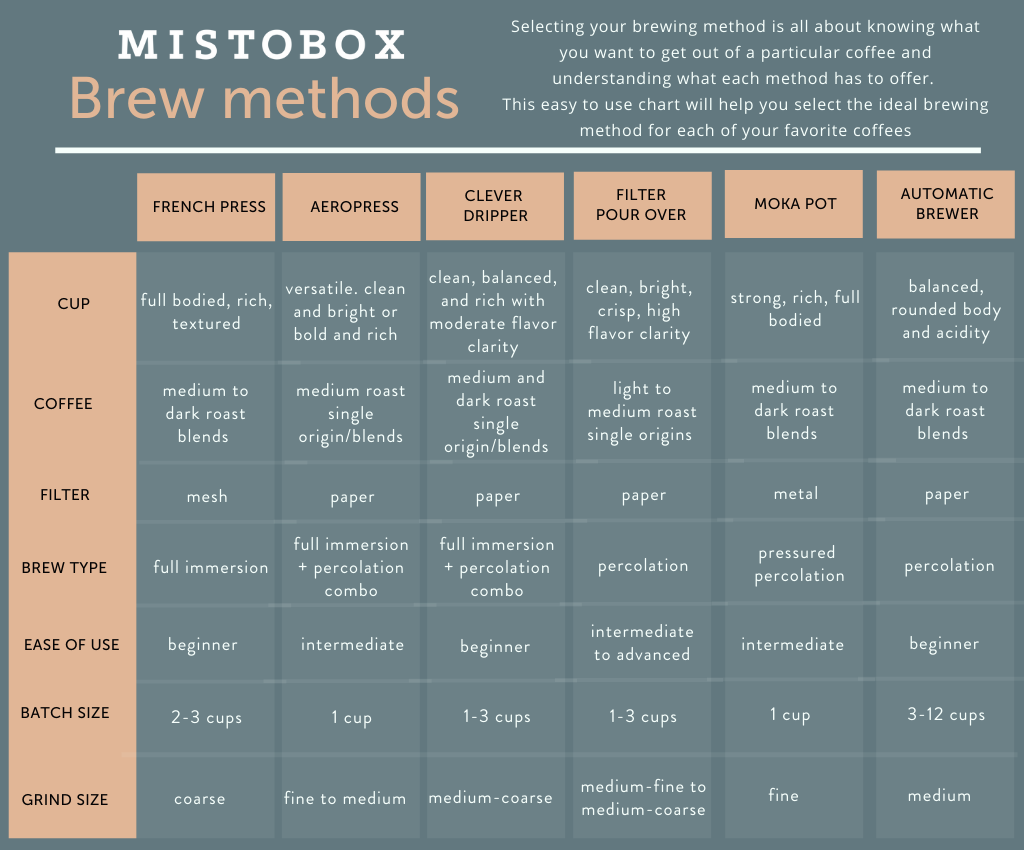
If your coffee tastes too sour, bright, acidic, or weak try the following:
- using a higher brew ratio (increase the amount of coffee used in relation to water)
- using a slightly finer grind
- agitating (stirring) the grounds while brewing
- increasing water temperature
- increasing contact/brew time
If your coffee tastes too bitter, intense, chalky, or bold try the following:
- using a lower coffee to water brew ratio (decrease the amount of coffee used in relation to water)
- using a coarser grind
- decreasing contact/brew time
- decreasing water temperature
For more factors that influence the taste of home brewed coffee check out our article on the science of brewing coffee.
Learn more about coffee and taste with our series and check out our Specialty Coffee article, Guide to Coffee Cupping or Strong vs Rich vs Bold Coffee: What’s the difference? and Understanding Coffee Taste.

